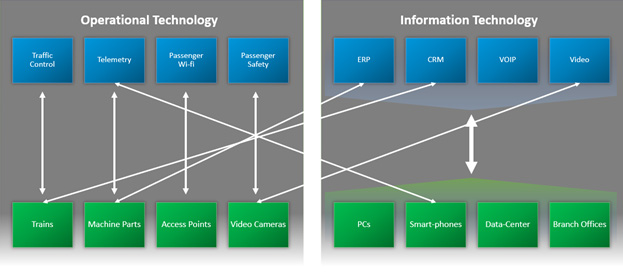Basic infrastructure communication has evolved in a very rapid direction with the need for higher bandwidth, a higher level of security, and demand for true resiliency models. I want to start by level setting on my view of IIoT 4.0 and what it means to me—Use of Cyber-Physical systems to enhance and automate the value chain in the manufacturing process.
Let’s rewind a little. In the 70’s and 80’s, we set out to work on the 802 initiative, and 802.3 (10Base5), 802.4 (TokenBus), and 802.5 (TokenRing) took life, becoming standards. It was not until the late 80’s when we landed with LattisNet and a blazing 10MBS using twisted pair. At the time, we never would have envisioned that more than that would be needed.
We have seen an evolution of industrial networks that relied on pure traditional sensors that transmit an amount of digital data used for telemetry (low bit count) to video images in RGB/RGBHV and IR formats filling the pipe and requiring higher bandwidths. Also, to compound the situation, tighter integration of real-time data with business data for real-time analytics, performance monitoring, dashboards, etc.

This evolution alone has created a need for much higher bandwidth networks, with a greater level of security and resiliency to meet the changing environments. The interconnected future requires an extremely rigid adherence to security while still maintaining the simplicity to the network.
Gaining in momentum is the inclusion of higher-speed wireless technology; in the strategy, creating an environment that can provide a seamless net of coverage over a large geographic area, enabling worker access to company information, equipment history, and diagnostic information. Seamless and secure integration is crucial to a dynamic IIoT environment. Deploying a network to support the levels of connectivity required to realize it in a dynamic and potentially hazardous environment can be extremely difficult. Ensuring an equilibrium between facility and production growth with employee safety standards in the industry is imperative. Consequently, for a network infrastructure to be fit for purpose in the context of a production field, a refinery or petrochemical plant, some requirements must be met.
For instance, many sites operate multiple networks to accomplish separate communication needs for their employees. This often outweighs the burden of maintaining a Wi-Fi network for data and a two-way radio WAN for voice, which can generate significant costs and can be a notable drain on resource demands for daily operations.
For facilities to circumvent these obstacles and realize a connectivity option to meet the demands of Industry 4.0, and future proof their investment, they must turn to a new type of networking.
An IIoT-enabling network, more dynamic than Wi-Fi networks or two-way radio WAN, can give the operator the prerogative to take advantage of the innovative technologies that can maximize productivity, improve safety, and help organizations survive amid increased competition.
A feasible solution is for operators is to implement a mesh network topology—a resilient architecture constructed of nodes that allows a multitude of devices to connect to each other wirelessly. The result is a node network that can communicate data across the network. Every aspect of exploration, extraction, and production must always be carefully monitored and managed to ensure continuous operations and cost-efficiency. A mesh network can provide real-time, site-wide communications for the varying personnel and assets crucial to the running of a petrochemical plant, including drills, wellheads, video cameras, smart meters, sensors, laptops, and smartphones.
Key benefits to IIoT:
- Enhanced visibility; access to real-time information creates a sense of control in the decision-making process, allows for performance modeling and greater forecasting accuracy
- Increased flexibility and decision-making
- Improved efficiency and up-time
- Shorter product transitions and less waste
- Improved financial performance
Part 2 will deal with laying out the architecture. 🖉













